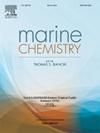Reactivity and fluxes of antimony in a macrotidal estuarine salinity gradient: Insights from single and triple quadrupole ICP-MS performances
IF 2.5
3区 地球科学
Q2 CHEMISTRY, MULTIDISCIPLINARY
引用次数: 0
Abstract
Trace element analyses in brackish waters are challenging for many elements at ppb/ppt levels and analytical methods. In this work, we compare two methods using inductively coupled plasma mass spectrometry (ICP-MS) for quantifying antimony (Sb). Results of a previous study along the salinity gradient in a macrotidal estuary (i.e., the Gironde Estuary, France) using isotopic dilution via single quadrupole ICP-MS are compared to reanalyzed aliquots of the same samples. Direct analyses of estuarine water samples via standard additions (N = 52) were performed with a QQQ-ICP-MS (new generation, iCAP TQ Thermo®) to determine dissolved (< 0.2 μm filtered and UV-irradiated replicates) Sb concentrations during two contrasting hydrological conditions (low vs high freshwater discharges). Despite following good analytical practices on both studies, the use of the new analytical device provides more robust results and highlighted a characteristic 121Sb isotopic interference in estuarine samples at S > 20, efficiently eliminated by the QQQ-ICP-MS performance. This means that Sb reactivity shows an additive, non-conservative behavior in the Gironde Estuary, with a more defined bell-shaped profile in low discharge compared to high discharge conditions. This approach allows to quantify for the first time in the literature Sb dissolved net fluxes from the Gironde Estuary to the Atlantic coast and provides an updated value for the seawater endmember. This study opens future applications of QQQ-ICP-MS for quantifying on a more routine basis dissolved trace elements in brackish waters, providing guidelines and good practices for field studies regarding Sb determination in estuarine systems.
大潮汐河口盐度梯度中锑的反应性和通量:从单四极杆和三重四极杆 ICP-MS 性能中获得的启示
咸水中许多元素的ppb/ppt含量和分析方法对痕量元素分析都具有挑战性。在这项工作中,我们比较了使用电感耦合等离子体质谱法(ICP-MS)量化锑(Sb)的两种方法。通过单四极 ICP-MS 进行同位素稀释,将之前在一个大潮汐河口(即法国吉伦特河口)沿盐度梯度进行的研究结果与重新分析的相同样本等分进行了比较。使用 QQQ-ICP-MS(新一代,iCAP TQ Thermo®)对通过标准添加物直接分析的河口水样(N = 52)进行了分析,以确定在两种截然不同的水文条件下(淡水排放量少与淡水排放量多)的溶解锑浓度(< 0.2 μm 过滤和紫外线照射重复样品)。尽管这两项研究都遵循了良好的分析方法,但使用新的分析设备得出的结果更加可靠,并突出显示了河口样本在 S > 20 时的 121Sb 同位素干扰特征,QQQ-ICP-MS 的性能有效地消除了这一干扰。这意味着,在吉伦特河口,锑的反应性显示出一种添加性的非保守行为,与高排水量条件相比,低排水量条件下的钟形曲线更为清晰。这种方法首次在文献中量化了从吉伦特河口到大西洋沿岸的锑溶解净通量,并提供了海水末端分子的最新值。这项研究开启了 QQQ-ICP-MS 在咸水溶解痕量元素常规量化方面的未来应用,为河口系统锑测定方面的实地研究提供了指南和良好实践。
本文章由计算机程序翻译,如有差异,请以英文原文为准。
求助全文
约1分钟内获得全文
求助全文
来源期刊

Marine Chemistry
化学-海洋学
CiteScore
6.00
自引率
3.30%
发文量
70
审稿时长
4.5 months
期刊介绍:
Marine Chemistry is an international medium for the publication of original studies and occasional reviews in the field of chemistry in the marine environment, with emphasis on the dynamic approach. The journal endeavours to cover all aspects, from chemical processes to theoretical and experimental work, and, by providing a central channel of communication, to speed the flow of information in this relatively new and rapidly expanding discipline.
 求助内容:
求助内容: 应助结果提醒方式:
应助结果提醒方式:


